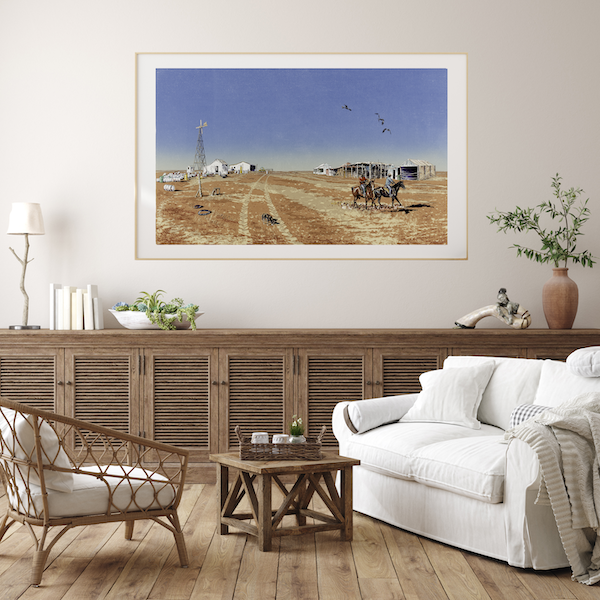
Enhance your collection with our limited edition prints and reproductions. Our artworks, wallpapers and stationery also make beautiful personal or corporate gifts. If you have any questions regarding our products please contact us. Original Richard Weatherly artworks are also available for sale at the Richard Weatherly store.
Muster Time
Screen Print on Paper
Edition of 94
590 x 960 mm
Sitting in the kitchen at Roseberth Station and enjoying a cup of tea with the hospitable owners, I realised that from the back door could be seen a quintessentially central Australian station scene. The arrangement of the buildings and the used drums and other items combined with the tracks to form a wonderful image. The main question became, what medium should I use? Initially, I painted this scene in gouache, but somehow that didn’t seem to convey the atmosphere of light and heat sufficiently. I began again in oil paints on canvas, and somewhere in Canada, there is a painting hanging with that secret behind it, since I painted another image over the top. Eventually, I worked the image as a screen print, after being shown the printing technique by a seriously competent print artist, Ann Senechal Faust, when I was trapped in her house in Baton Rouge by a raging hurricane outside.
What is a Serigraph?
A Serigraph is a multicolour printing technique that originated in America. Since the first exhibition of Serigraphs at the New York World Fair in 1939, it has become a widely accepted medium for artists to create original prints.
The name “Serigraph” indicates an artist’s hand-made original screen-print as distinguished from screen-printing work executed in an industrial or purely reproductive manner.
The method uses stencils. The designs are placed on a piece of fine mesh fabric (originally silk, hence the name “silkscreen” printing) attached to a wooden or metal frame; various film-forming materials, as well as hand-cut film stencils and photo-sensitive emulsions, are used as resists. The frame is about two inches deep so that it forms a box with the screen fabric constituting the bottom. Colour in the correct semi-liquid consistency is then poured into the frame, the frame is placed in contact with the surface to be printed, and the ink is wiped over the stencil with a squeegee, forcing it through the mesh of the uncoated areas of the fabric on to the paper below. The paper is then replaced with a clean sheet and the process repeated. For each separate colour in the printed image, the screen is changed and the paper is carefully realigned and printed, being allowed to dry between colour applications. Gradually the image is built up through a series of generally monochrome designs.
Ref: “The Artist’s Handbook of Materials and Techniques” Ralph Mayer,
Faber & Faber Ltd, 1981
All paintings sold without stretching and framing and are delivered rolled in a tube. Stretching and framing are available upon request, please contact us to discuss price and delivery.
